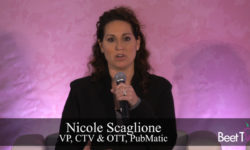SANTA MONICA — Addressable TV has built the footprint, now it has to walk the walk.
In recent years, more TV households have got lit-up with the capability to swap-out specific ads for specific homes.
In this video interview with Beet.TV’s Jon Watts at Beet Retreat Santa Monica, Ampersand CEO Nicolle Pangis says utilization of the capability has not been widespread enough. She offers ideas to turn that around.
Scaled quickly
“It is not moving forward probably at the pace it could or should based on the supply that’s entering the market,” Pangis acknowledges. “I think money’s not followed the eyeballs in addressable as it could or should.
“We’re making a lot of progress on … creating data sets that match in the privacy compliant way on the front end and being able to provide a privacy compliant measurement…”
But it’s not all gloom.
“Four years ago we started with zero,” Pangis adds. “We’re at 42 million households of data, so that’s pretty scaled, pretty quickly.”
Addressable roll-out
Ampersand’s Rosen Urges Local Innovation, Sees New Era Of Focus
Addressable TV has remained largely available in local cable inventory, but a variety of initiatives aim to change that.
In 2019, Comcast, Charter and Cox launched the On Addressability initiative. Project OAR also involved TV makers like Vizio, promising a technical standard for addressable advertising placements.
Ampersand is the former NCC Media, a cable TV ads integrator owned by three US cable operators.
Now reconstituted as “the total TV company”, its platform helps advertisers define and find audiences, plan and execute ad schedules, and measure and report their outcomes.
The outfit boasts viewership insights and planning on more than 40 million households, in every DMA, across more than 150 networks and in all dayparts.
It is owned by Comcast, Spectrum and Cox, as well as Verizon and other MVPDs, but also now is the exclusive seller of Verizon Fios’ addressable ad space.
Data concerns
One problem with addressability’s slow expansion is the value of data itself.
“Brands that have first-party data are very reticent to even give that to their agencies,” says Ampersand’s Pangis.
“Figuring the dynamic between brand, agency and companies like Ampersand or any supplier media, that takes time to work out.”
She thinks clean room software, which allows data sets to be commingled without revealing privacy-sensitive details, will help smoothe the path.
Build a bridge
Asked if next year’s big priority should be to try and build bridges between MVPD network addressable and CTV streaming programmatic addressable, Pangis agreed.
“A hundred percent,” she said.
“The identity companies play a huge part in that and they, they’re making a lot of traction there too, because that’s a way to bridge the two, the two worlds for sure.














































